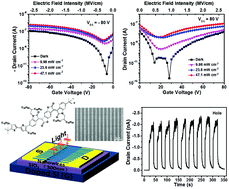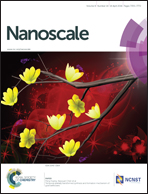Enhanced near-infrared photoresponse of organic phototransistors based on single-component donor–acceptor conjugated polymer nanowires†
Abstract
Single-component near-infrared phototransistors based on ambipolar organic semiconductor nanowires have been investigated and compared with their corresponding thin-film counterparts. The nanowire organic phototransistors (NW-OPTs) showed photocurrent/dark-current ratios and photoresponsivities as high as 1.3 × 104 and 440 mA W−1 for the p-type channel, and 3.3 × 104 and 70 mA W−1 for the n-type channel, respectively, upon near-infrared illumination with an intensity of 47.1 mW cm−2. These were much higher values compared to their thin-film counterparts. The enhancement of the near-infrared photoresponse could be attributed to the larger trap density originating from the semiconductor/insulator interface and the semiconductor/air interface. The performance of NW-OPTs was demonstrated to open up new possibilities to improve the near-infrared photoresponse of single-component devices.


 Please wait while we load your content...
Please wait while we load your content...